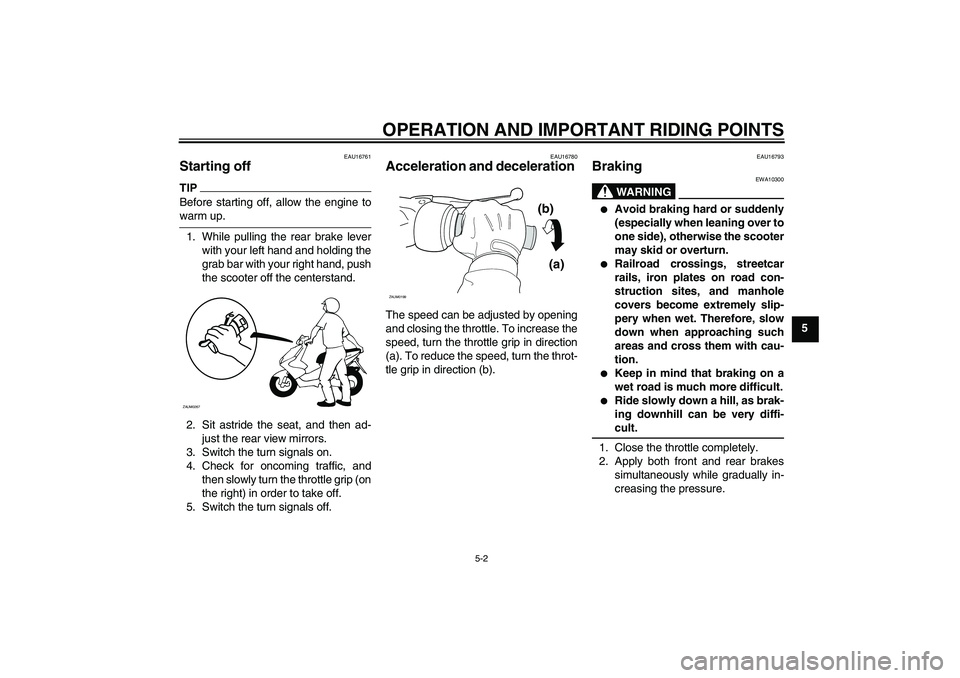Page 17 of 68

INSTRUMENT AND CONTROL FUNCTIONS
3-4
3
EAU12140
Fuel gauge The fuel gauge indicates the amount of
fuel in the fuel tank. The needle moves
towards “E” (Empty) as the fuel level
decreases. When the needle reaches
“E”, refuel as soon as possible.TIPDo not allow the fuel tank to empty itselfcompletely.
EAU12347
Handlebar switches Left
Right
EAU12400
Dimmer switch“/”
Set this switch to“” for the high
beam and to“” for the low beam.
EAU12460
Turn signal switch“/”
To signal a right-hand turn, push this
switch to“”. To signal a left-hand
turn, push this switch to“”. When re-
leased, the switch returns to the center
position. To cancel the turn signal
lights, push the switch in after it has re-
turned to the center position.
EAU12500
Horn switch“”
Press this switch to sound the horn.
EAUM1132
Start switch“”
Push this switch while applying the
front or rear brake to crank the engine
with the starter. See page 5-1 for start-
ing instructions prior to starting the en-
gine.
1. Fuel gauge
E1/2
F
1
ZAUM0257
1. Horn switch“”
2. Turn signal switch“/”
3. Dimmer switch“/”
1. Start switch“”
U3C6E1E0.book Page 4 Friday, August 8, 2008 10:09 AM
Page 18 of 68
INSTRUMENT AND CONTROL FUNCTIONS
3-5
3
EAU12900
Front brake lever The front brake lever is located on the
right handlebar grip. To apply the front
brake, pull this lever toward the handle-
bar grip.
EAU12950
Rear brake lever The rear brake lever is located on the
left handlebar grip. To apply the rear
brake, pull this lever toward the handle-
bar grip.
EAUM2081
Fuel tank cap To remove the fuel tank cap
1. Open the fuel tank cap lock cover.
2. Insert the key into the lock and turn
it 1/4 turn counterclockwise. The
lock will be released and the fuel
tank cap can be removed.
To install the fuel tank cap
1. Push the fuel tank cap into position
with the key inserted in the lock.
2. Turn the key clockwise to the orig-
inal position, and then remove it.
3. Close the lock cover.
1. Front brake lever
1
ZAUM0084
1. Rear brake lever
1
ZAUM0085
1. Fuel tank cap
1
ZAUM0262
U3C6E1E0.book Page 5 Friday, August 8, 2008 10:09 AM
Page 29 of 68

OPERATION AND IMPORTANT RIDING POINTS
5-2
5
EAU16761
Starting off TIPBefore starting off, allow the engine towarm up.
1. While pulling the rear brake lever
with your left hand and holding the
grab bar with your right hand, push
the scooter off the centerstand.
2. Sit astride the seat, and then ad-
just the rear view mirrors.
3. Switch the turn signals on.
4. Check for oncoming traffic, and
then slowly turn the throttle grip (on
the right) in order to take off.
5. Switch the turn signals off.
EAU16780
Acceleration and deceleration The speed can be adjusted by opening
and closing the throttle. To increase the
speed, turn the throttle grip in direction
(a). To reduce the speed, turn the throt-
tle grip in direction (b).
EAU16793
Braking
WARNING
EWA10300
�
Avoid braking hard or suddenly
(especially when leaning over to
one side), otherwise the scooter
may skid or overturn.
�
Railroad crossings, streetcar
rails, iron plates on road con-
struction sites, and manhole
covers become extremely slip-
pery when wet. Therefore, slow
down when approaching such
areas and cross them with cau-
tion.
�
Keep in mind that braking on a
wet road is much more difficult.
�
Ride slowly down a hill, as brak-
ing downhill can be very diffi-cult.
1. Close the throttle completely.
2. Apply both front and rear brakes
simultaneously while gradually in-
creasing the pressure.
ZAUM0267
(b)
(a)
ZAUM0199
U3C6E1E0.book Page 2 Friday, August 8, 2008 10:09 AM
Page 56 of 68

PERIODIC MAINTENANCE AND ADJUSTMENT
6-25
6Engine overheating
WARNING
EWA10400
�
Do not remove the radiator cap when the engine and radiator are hot. Scalding hot fluid and steam may be
blown out under pressure, which could cause serious injury. Be sure to wait until the engine has cooled.
�
After removing the radiator cap retaining bolt, place a thick rag, like a towel, over the radiator cap, and then
slowly rotate the cap counterclockwise to the detent to allow any residual pressure to escape. When the hissingsound has stopped, press down on the cap while turning it counterclockwise, and then remove the cap.
TIPIf coolant is not available, tap water can be temporarily used instead, provided that it is changed to the recommended coolantas soon as possible.
Wait until the
engine has cooled.
Check the coolant level in the
reservoir and radiator.
The coolant level
is OK.The coolant level is low.
Check the cooling system
for leakage.
Have a Yamaha dealer checkand repair the cooling system.Add coolant. (See TIP.)
Start the engine. If the engine overheats again,
have a
Yamaha dealer check
and repair the cooling system.
There is
leakage.
There is
no leakage.
U3C6E1E0.book Page 25 Friday, August 8, 2008 10:09 AM